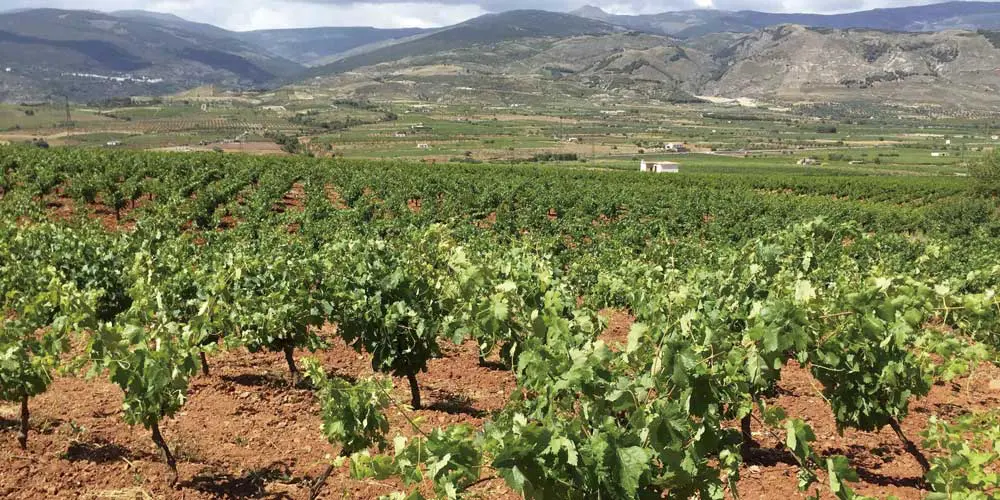Drinking Wine in ANTEQUERA
Buying wines in ANTEQUERA


Supermarkets
Wine prices in the supermarkets of Antequera (and throughout Spain) offer excellent value for money, compared to elsewhere in Europe. A basic, but easy drinking wine can be available for around 2.5 euros.
The depth of variety on display depends on the supermarket, but you can easily accrue a good value home wine rack for your holiday.
Price comparisons between supermarkets, are not fruitful timewise. Where a brand of wine is commonly stocked, the prices will be the same, or almost. It is the depth and breadth of wines on offer which may determine your supermarket of choice.
Carrefour, Lidl, and Maskom have the best range. If you are interested in wines, these would be the recommendation.
Carrefour often have reduced price offers on a two bottle purchase of the same wine. The second bottle price reduction is sometimes as much as 70%. This means you can aim for a higher quality wine at a lower price than perhaps your usual budget.
Lidl offers a quite extensive range of low to medium priced wines. Top end labels are not stocked. They do have some good promotional discounts on occasions.
Maskom is good at stocking brands you won’t find elsewhere. The wine section is not as large as some of the other mainstream stores, but there is an interesting variety.
Mercadona has a more limited choice, but they stock in bulk.
See the Shopping in Antequera section for supermarket choices.
Restaurants
Restaurants, by and large, offer wines not purchasable elsewhere (other than the internet – for example see Vivino.com). Proprietors tend to deal with local wine suppliers who don’t (can’t) cater for the mass volume buying supermarkets.
They may have one, or several wine agents supplying them, and they will be selecting wines based upon the customer profile, and of course, price. The owner will have his ideas on the highest and lowest levels of pricing the restaurant should offer. The mark up will vary from restaurant to restaurant, but on average it will start at 150%.
Most restaurants offer a decent selection of reds, whites and rose’s. The Finca Eslava Restaurant (see Restaurants in Antequera), has probably the most comprehensive wine list in Antequera. At the other end of the price scale, bustly Bar Carrera has one of the most integrated, with a compact range of wines offering very good value.
Again, see Restaurants in Antequera.
Spanish Wine Quality Classification
There are four classifications of wine quality in Spain. These are usually featured on the rear label.
DOCa (Denominacion de Origen Calificada) is the top level. There are only two regions that carry this designation, as the rules are very strict. These are Rioja, and Priorat.
I have never seen a wine from the Priorat region in Antequera. The region is in Catalonia. It has a very small level of production, and is one of the most expensive wines in Spain.
DO (Denominacion de Origen) indicates the wine is derived only from the region indicated on the label, and has the quality standard set for the region.
Vino de la Tierra. Literally this means ‘wines of the land’. These wines are not subject to the strict, and costly governmental classifications. Prices are thus lower in this category, and some can be superb value if shopping on price.
Vino de Mesa. ‘Table wine’. These wines do not fall into any of the above categories, and labels are unlikely to state a region or grape. Essentially, these are blends put together to offer a wine at the lowest cost price to the consumer.
There is a popular red wine drink called tinto verano (verano means summer). This is a mix of red wine and a light lemonade, with ice, thus, ideal for summer drinking! Vino de mesa will be used 99% of the time for this.
You may sometimes see the word Cosecha on the bottle label. This means ‘harvest’, and the number that follows denotes the year the wine was produced.
Whilst these days Spain produces wonderful red, white, rose and sweet wines, it is historically renowned for it’s red wine output.


Red Wines in ANTEQUERA and Spain
- Joven: A young wine. Sold within a few months of maturation. Perfectly drinkable, and low priced. The front label may not state ‘Joven’, but if there is no other classification then it is a young wine.
- Crianza: A wine in this category must be at least two years old, having spent a minimum of six months in a barrel, and the remainder bottled.
- Reserva: 3 years maturation minimum. 12 months in a barrel.
- Gran Reserva Maturation of 24 months in the barrel minimum. 36 months bottled.

Classification Purchasing
Some supermarkets and restaurants may offer all of these classifications. As mentioned the Carrefour supermarket is particularly good, and the aforementioned Finca Eslava restaurant, amongst others, stocks them all.
Where not, you will almost certainly be able to purchase Joven, Crianza and Reserva wines.
Red Wines Producing Regions
There are numerous red wine producing regions throughout Spain, of differing reputation and product.


Castille – La Mancha
In Antequera you will, for example, see on the supermarket shelves, and often restaurant wine lists, wines from Castille – La Mancha.
It is reputed to be the largest wine growing area in the world, with 1540 square miles (400,000 hectares) of vines, and is the largest producer of Spanish wine.
The wines you may spot are likely from Valdepeñas DO, and La Mancha DO. These are good value wines for the delivery.
Riojas
However, the area of prominence in terms of reputation in Spain, is of course, La Rioja.
The province of La Rioja lies in northern Spain, adjoining the wine growing region of Navarra (known for it’s quality rose wines).
White wines are produced here, but the province is famous for it’s reds.
Grapes used are Tempranillo, Viura, Garnacha, Graciano, Mazuelo.
La Rioja is the third largest producer within Spain, (after Castilla-La Mancha, and Catalonia) and, the most exported.
Rioja red wines are to be compared favourably to the reds of Italy and France.


Ribera del Duero
The respected wine growing area of Ribera del Duero is in Castilla – Leon, east of Valladolid.
Wines from Ribera del Duero are much favoured in Antequera.
Rivera del Duero means: riverbanks of the Duero.
These red wines are deep in colour, and robust.
The grape used almost exclusively is Tempranillo. The local name for this grape is Tinto Fino. It is the dominant red grape in the northern half of Spain.
Antequeranos will nearly always recommend a Ribero del Duero wine over a Rioja, as being of higher quality.
I disagree with this. There are lovely wines to be had from both regions. I suspect it is a local preference for full bodied red wines that leads to the discrimination.
For me there is more flexibility in the palate of Riojas, given the much larger output, and there is no comparable loss of quality.
However, Ribera del Duero wines are excellent.
Purchasing Red Wine
Ribera del Duero wines tend to maintain a slight price premium over equal classification Riojas.
A reason for this, aside from perceived quality, is that the weather conditions in the Ribera del Duero wine producing area restrict the annual output. It is also a much smaller area for wine producing compared to La Rioja.
Prices are therefore necessarily higher in order to cover the overheads of production.
- Supermarkets:
All supermarkets have a range of Rioja and Ribera del Duero reds.
There are Joven wines for 3 euros or less (even 2 euros, but not recommended, unless to be used for a tinto verano!).
You can buy a nice Crianza for under 5 euros.
After this it is a question of choice.
Enjoy experimenting! - Restaurants:
Most restaurants offer a good range of Riojas and Ribera del Dueros.
Restaurant prices for wine in Antequera naturally depend on the style of restaurant. A young wine should be available for around 9-12 euros. A reliable Crianza at 14 – 16 euros.
Red Wine Brands
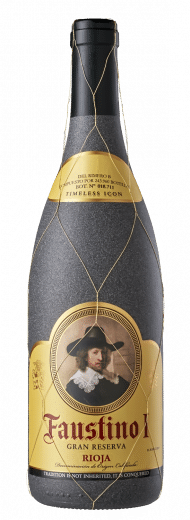
Faustino
One of the largest bodegas and distributors in Spain.
It is now an international brand sold in over 45 countries.
The wines of Faustino are uniquely labelled in quality denomination with a Roman numeral. The entry level of wine is Faustino VII. A guaranteed good value wine. It can be purchased in supermarkets for under 4 euros. In restaurants it can be anything from 12 – 14 euros.
The mid range Faustinos are denoted Faustino V, and are Crianzas.
Top level wines are Faustino I.
The labels of Faustino are distinguishable with a portrait of Nicolaes van Bambeek, painted by Rembrandt.
A safe purchase at all the levels.
Marques de Riscal
This is the oldest bodega in La Rioja, founded in 1860, by the Marques of Riscal.
You can only buy Marques de Riscal wines at Reserva and Gran Reserva levels.
You won’t pay less than 7 euros a bottle in a supermarket. But hey! Treat yourself.
The Marques de Riscal white wines are excellent too. In 1972 they established a bodega in Rueda, specifically for white wine producing (see the section on White Wines in Antequera).


Campillo
A young estate founded in 1990.
It is small, and purports to producing only high grade wines.
I think the prices in Antequera are not top end for this wine. If you can find a Crianza in a supermarket expect to pay around 8 euros.
Protos
This bodega was founded in 1927. It was the first winery in Ribera del Duero. (Protos in Greek means ‘first’).
It has an excellent reputation.
The wines are naturally robust, and oaky in taste.
You pay for the quality. 12 euros would be an estimated off the shelf price for a Protos crianza.
Maskom and Carrefour usually have a supply.


Marques de Caceres
This is a brand name you will see in virtually all supermarket wine sections.
The brand straddles red, white and rose wine varieties. It is a reliable name to go by if you are not yet accustomed to the wines of Spain. Prices are less than the four wine brands mentioned above.
A nice red crianza will be about 5 – 6 euros.
Yet, as stated, there is an abundance of good red wines to choose from in Antequera.
Pour gently, swirl vigorously, sniff, and drink heartily!
White Wines in ANTEQUERA
There are now great white wines (vinos blancos) to be enjoyed in Antequera. Spain will always be renowned as a principally red wine producing nation, but the white wine offering has come a long way since the days (only about 25 years ago) when vino blanco meant a white dry sherry. Even now, in Antequera, some of the older style bars don’t stock a non-fortified white wine. But, now, pleasingly for white wine lovers, there are Spanish wines worthy of distinction on the international white wine grid.
White Wine Classifications
The classification of white wines here is basically:
- Seco: a dry wine
- Semi-seco: medium sweet
- Dulce: sweet
However, there is a wide palate of tastes to be enjoyed under the tag ‘dry’. There are some enjoyable ‘medium sweet’ and ‘sweet’ wines too. (See the section on Sweet Wines)
White Wine Maturity Classification
The wine maturity classifications for red wines apply to white wines too, from Joven through to Gran Reserva.
As with reds, the year of production will be stated on the front label. However, only the maturity designator of Joven, and possibly Crianza, are likely to be found on white wines in Antequera. High grade whites are sadly not yet available.
Moving on, the young Barbadillo wine (see below), and as mentioned earlier in Eating and Drinking, was universally the white wine served in restaurants and bars. It is still widely stocked, and has recently extended it’s range, including a light effervescent white wine, in order to liven up it’s image as well as turnover.
This brand though has been superceded, in our opinion, by dry white wines of higher quality and value. There are now some wine producing regions offering great whites for consumption.
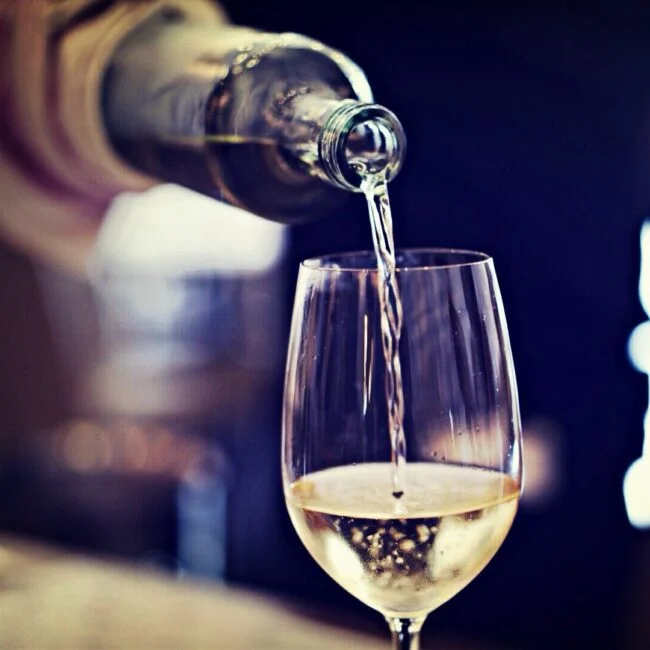
White Wine Producing Regions
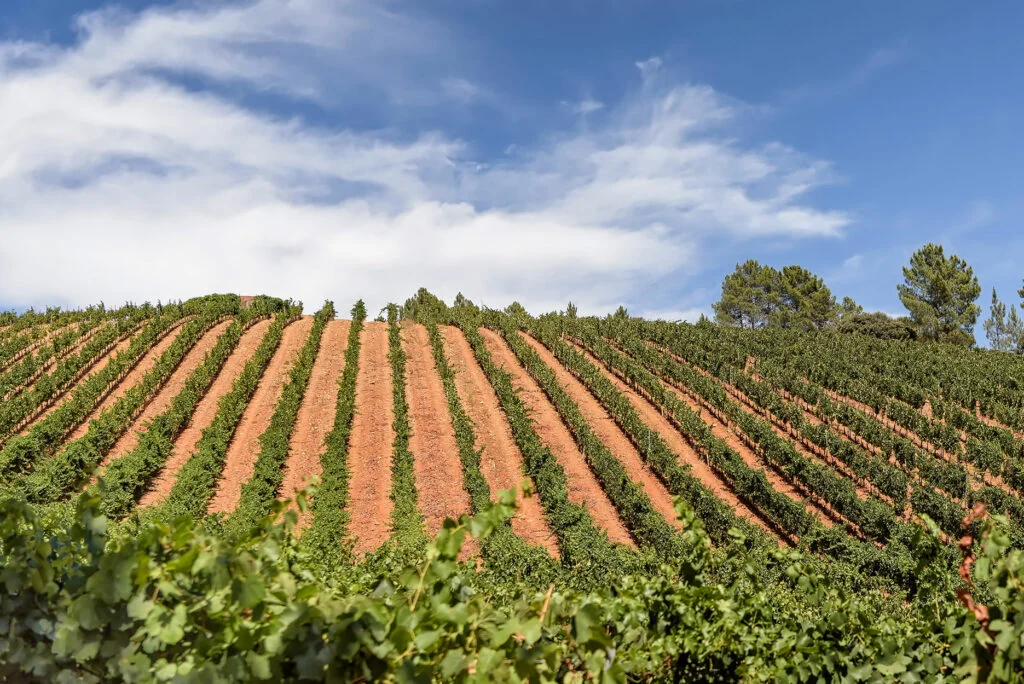
Rueda
Quality white wines from the predominantly white wine producing area of Rueda are now, thankfully, widely on offer in Antequera, and Andalusia.
Rueda lies in the northern province of Castilla – Lyon.
It is one of Spain’s leading white wine regions.
Verdejo Grape
The main grape grown there is Verdejo. Of the 32,500 acres of vineyards in Rueda, nearly 29,000 are given over to verdejo.
The verdejo grape produces a quite full bodied, aromatic and fruity white wine.
Verdejo based wines are excellent value for money for the taste delivery.
White wines labelled ‘Rueda Verdejo’, must contain a minimum of 85% verdejo grape.
The best Ruedas Verdejo’s are 100% verdejo grape. You will see this proudly stated on the wine label. You pay a bit more, but it’s worth every centimo!

A wine labelled simply ‘Rueda’, may be only 50% verdejo.
Grapes that are blended with verdejo are Sauvignon Blanc, Viura, and Palomino.
Perfectly good, though they obviously dilute the character of the pure verdejo grape.
Why confuse it by blending? The reason is blended wines enable extended distribution, at a cheaper price for the consumer. Thus more wine sold. And, it has to said, more affordable choices for us.

Grupo Yllera is one of the leading wineries in Rueda, and if you spot a verdejo, or a sauvignon blanc for that matter, bearing the Yllera name, you have a winner.

Albariño Grape
Albariño is a variety of grape much appreciated in Spain. It is grown principally in Galicia. The best examples are from Rias Baixas DO, on the Atlantic coast, near the Portuguese border.
There are several albariño based white wines to be had in the supermarkets of Antequera.
They are a little higher priced than the verdejos or sauvignon blancs.
Albariño wines have a lovely light and mildly fruity taste. Best well chilled.
If you can find it, Mar de Frades Albariño is a brand worth paying for.
Godello Grape
Another DO designated wine producing area in Galicia is Valdeorras. Here the Godello grape is favoured, producing clean, crisp light flavours.

La Rioja
White wines from the famous la Rioja region are made, predominantly, with the Viura grape, though Tempranillo Blanco and Garnacha Blanco are also traditionally used in blends. Whilst the younger wines tend to be light, with not much fruit or body, the region is praised for it’s ability to produce whites that can age for 10 years or more – rare for a white wine – which are full bodied. Some of these carry the maturity classification of Gran Reserva, such as the praised Valserrano Rioja Blanco Gran Reserva.
Rioja whites you are more likely to find in Antequera though are Campo Viejo, El Coto, Cune, Faustino V, and Marques de Caceres, amongst others.
Rioja also produces a good medium sweet wine in Diamante.
Valdepeñas
Valdepeñas is in the south of Castilla – La Mancha, in central Spain. It is better known as a red wine producing region, but white wines are also produced here using blends of Airen, Chardonnay, Macabeo, Sauvignon Blanc, and Verdejo grapes.
Valdepeñas brands you will certainly spot are Vina Albali, Tierra de Oro, and Castillo de Soldepenas.

Purchasing White Wines
There are many good white wines on offer in Antequera supermarkets, and restaurants. The range of white wines in supermarkets is usually slightly less than the reds, and this is reflected too in wine lists in restaurants, but there is plenty to choose from.
- Supermarkets:
All supermarkets have a range of Verdejo based wines, white Riojas, Albarino wines, and more commonly now Sauvignon Blanc and Chardonnay.
Prices start from around 2.5 euros. - Restaurants:
Most restaurants offer a choice of Verdejo wines and white Riojas. Sometimes Albarino, Sauvignon Blanc, and Chardonnay based wines may be offered. Unlike supermarkets, where pricing is pretty stable regardless of outlet, starting prices in restaurants vary from venue to venue, sometimes quite markedly. A Verdejo on sale for 10 euros in one restaurant can be 14 euros in another around the corner. Obviously the smarter establishments are likely to be charging the higher prices.

Marques de Riscal Verdejo
Mentioned above in the red wine section. A pure verdejo. Price around 7.50 euros. Mercadona stocks this, amongst others.
A gem!
Rueda Blume Verdejo
Lovely. Full taste, but not too much acid. Reliable.
Sometimes available in Carrefour, or Mascom. A great wine. The price is around 6 euros.
Sauvignon Blanc Brands
For a nice sauvignon blanc try Pata Negra, Jose Pariente (fabulous), Marlborough, Ramon Bilbao, which are all reliable names. Marques de Riscal once again shines here. Prices will vary depending on the brand, but should start from around 6 euros in the supermarket, and upwards of 15 euros in restaurants.


Chardonnay Brands
There are tempting Chardonnay’s to be found too. Some good names are Enate, from Somontana; Cloe, from Sierras de Malaga; Laus, Somontano; Bach, Catalunya. Pricing is much the same as for the Sauvignon Blancs. You should find some in the favoured supermarkets for wine shopping (see Shopping in Antequera).
Marques de Caseres
The ubiquitous Marques de Caseres brand from La Rioja is widely available, particularly in supermarkets, now offering a Sauvignon Blanc and a Chardonnay. Prices will be around 5 euros plus in the supermarket, and likely 14 euros upwards in restaurants.
Barbadillo
You will see Barbadillo (Castillo de San de Diego) on all supermarket shelves, and usually on restaurant wine lists. It is produced mainly in Sanlucar de Barremeda in the Cadiz region, using the Palomino Fino grape. The company was founded in 1821 by Benigno Barbadillo, and is one of Spains oldest wine producers. It is classified as a Vino de la Tierra de Cadiz. It should be priced at around 4 euros in supermarkets, and 12 euros upwards in restaurants.
***
If you are here for a while, and unfamiliar with Spanish wines, experimenting is an inexpensive pleasure.
Go for it!
Note: If dining in a restaurant, be sure to ask for your chosen white wine in an ice bucket: Cubeta de hielo. It is not always automatically provided.
Sparkling Wines in ANTEQUERA
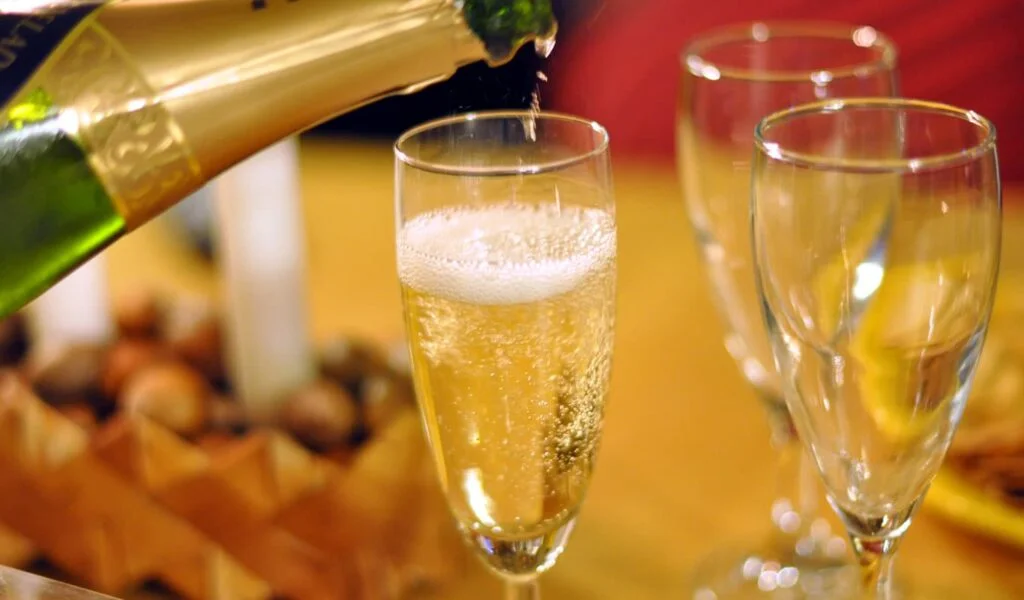
All Spanish sparkling wine, known as Cava, has to be made by a traditional method of bottle fermentation (methode chamenoise).
Originally this wine was known as Champan de Cava (cellar champagne).
When Spain joined the European Community, France requested the name Champan be forbidden.
From then on, the wine has been known simply as Cava. But Cava has never needed to fear a comparison with champagne. Some of the quality cavas are superb.
Cava Producing Regions
Cava sales have brought prosperity to it’s region of origin, Penedes, south of Barcelona.
Cava is actually though a sparkling wine appellation that covers a number of regions which are approved to produce it. These regions are: Pais Vasco, Catalonia, La Rioja, Aragon, Valencia, Extremedura, Navarra.
The grapes traditionally used for cava production are Xarel-lo, Viura and Parellada. More recently, single variety cavas made from Chardonnay are on the market.
Apart from consumption in Spain, it is widely distributed abroad. You will likely have it in supermarkets at home. Many of the supermarket chains outside of Spain have their own house branded cava on the shelves.
It is often favoured over champagnes due to the quality you can get for a much lower price.
In addition to the many small wine producers of cava you will see on supermarket shelves in Antequera, there are two major producers under the names Codorniu and Freixenet.
The entry level Freixenet bottle is easily spotted in the wine section of supermarkets due to it’s distinctive opaque black bottle.
You will see both of these brands, offering a range of their cavas on the supermarket shelves. The quality of these two brands is reliable. They are not at the cheap end of the price scale but are good value.
Types of Cava are graded according to their sugar content and alcoholic content.

Cava Gradings

- Dulce – sweet. High sugar content: more than 50 grams per litre.
- Semi seco – medium dry. 33 – 50 grams per litre.
- Seco – dry. 17 – 35 grams per litre.
- Extra seco – extra dry. 12 – 20 grams per litre.
- Brut – 0 – 15 grams per litre.
- Extra Brut – The lowest sugar level with 0 – 6 grams per litre
- Brut Nature – 0 grams
There is sometimes a perception that dry cavas are superior in quality to sweet ones. This is not the case. The level of quality is unrelated to the level of sweetness. It is purely a question of taste preference.
Some cava producers offer a cava vintage, which is a year when particularly good cava was produced.
Purchasing Cava
Prices for cavas can be ridiculously cheap.
You can get a low end bottle of cava for around two euros in some supermarkets.
If you are making a bucks fizz (cava with orange juice), then there is no problem with using a cheap cava. Spend a bit more on the orange juice!
If you are looking for a cava with more quality, spend 7 euros or more. After all, you are on holiday in lovely Antequera!
Pop that cork, and enjoy!

Rose Wines in ANTEQUERA

Rose wine (vino rosado), is not drunk as much in Antequera, as reds or whites.
But there is plenty on offer in the supermarkets, and to a lesser extent, in the bars and restaurants.
Rose Production
A rosado can be produced from a blend of white (the larger proportion) and red grapes. This mix is known as a clarete. It can also be produced from white grapes that turn reddish in colour following fermentation. And, too, it can be produced from red grapes, that are fermented for a few hours before pressing.
Confusing? Probably yes, but it is the result that counts, and Spanish rosados are amongst the finest in the world.
Rose Wine Producing Regions
Navarra
Navarra is probably the highest profile wine area producing rosado wines. It’s rosados are considered to be some of the best wines in Spain.
Navarra is in the far north of Spain, on the French border. It is famed for it’s July San Fermin bull running fiesta, in Pamplona. But it is also famed for it’s fine cuisine and quality wine bodegas.
A wide range of grapes can be used in producing rosados, including, commonly, Garnacha, Verdejo, Albillo and Viura.
However, some of the best Navarra wines employ blends of Tempranillo, Merlot, and Cabernet Sauvignon.
If you are trying a Spanish rose for the first time, one from Navarra would be a safe choice.


Cigales
Another region known for it’s vino rosados is Cigales, near Valladolid, in Castille – Leon.
Rose wines here were traditionally made using the clarete method. However, comparatively more recently they have been pressing wine from the Tinta del Pais grape. These wines have been applauded for their fruity quality.
Valencia
Valencia too, produces valued rose wine. It comes largely from the DO Utiel-Requena area, containing nearly 154 square miles of vines, in the land and mountains. The principal grape variety is the red Bobal, which has a good reputation as a rosado grape.
Yet, rose wine is produced in many regions of Spain.
Purchasing Rose Wines

In Antequera you should find an interesting variety on supermarket shelves.
Price-wise, rose’s are more or less in line with white wines. Quality and price go hand in hand.
There is nothing like a well chilled glass of rosado, for the summer evenings, on your Antequeran terrace!
Sherry in ANTEQUERA

Origin of Sherry
In 1587 Sir Francis Drake of England, attacked the province of Cadiz.
He reportedly took 2900 barrels of a delicious wine, which were being stored for the Spanish Armada.
The wine was produced in the town of Jerez de la Frontera. This town was then called Xerish. The name was derived from the Moorish word scherisch.
The English couldn’t easily pronounce it. So they called it ‘Sherry’.
Uniquely Andalusian
Now, only the wines from the ‘Golden Triangle’ towns of Jerez de la Frontera, Sanlucar de Barremeda, and El Puerto de Santa Maria, in the province of Cadiz, can bear the Sherry name.

Sherry Grapes
The grapes there grow on white, chalk rich soils, which are good for storing rain water in this dry region.
The main grape used for sherry is Palomino Fino.
For sweet sherries, Pedro Ximenez and Moscatel may be added.
Types of Sherry

Fino
Fino sherries are a pale golden colour, and dry. The alcohol content is between 15.5 and 17 degrees.
It is produced in the bodegas of Jerez and El Puerto de Santa Maria.
In Antequera, and throughout Andalusia, fino is usually drunk before a meal, as it is considered to prepare the palate to better enjoy food.
Manzanilla
This light in colour, and very dry sherry, comes exclusively from Sanlucar de Barrameda. It has a slight fragrance to it.
It is widely drunk, with or without a tapa.
Manzanilla is conventionally served at room temperature. However, it is nice drunk chilled too, if you care to put a bottle in the fridge overnight.

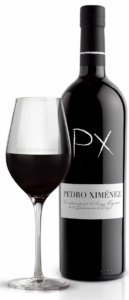
Pedro Ximenez
This is an elegantly sweet sherry. It has an alcohol content of around 17 degrees.
It is a lovely, well respected, sipping wine and is also recommended for recipes requiring a hint of sweetness in sauces.
A bottle of Pedro Ximenez carries a deserved price premium in supermarkets over other sherries.
The following types of sherry may not be readily available in Antequera. They are listed anyway, for reference.
Amontillado
A darker, aromatic, and higher alcohol sherry, with a content of between 16 – 18 degrees.
Amontillado is dry, though less so than Manzanilla, with a nutty aroma, and a slightly bitter taste.
Oloroso
A dark, full bodied sherry. It comes dry or medium. Alcohol content 18 – 20 degress.
Pale Cream
Made with Palomino grapes. It is quite sweet.
Cream
This type of sherry is made when sweet wine from the Pedro Ximenez grapes are added to Oloroso. Hence, it is dark in colour, and aromatically sweet.
Sweet Wines in ANTEQUERA
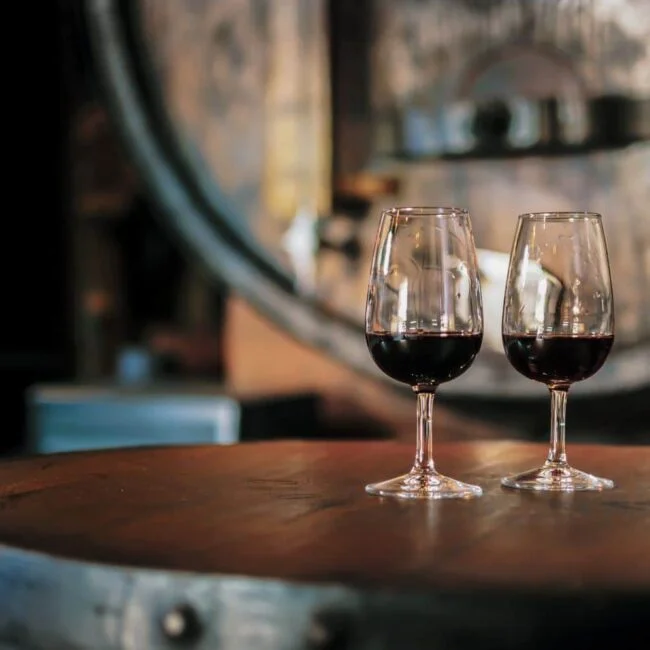
Sweet wine (vino dulce) is commonly drunk in Antequera (and throughout Spain) during the day, and not just as a dessert wine after a meal.
Bars will usually have large boxed wines, poured from the tap. Alternatively, they may have one or two small barrels on the bar, or work counter, given over to sweet wines. They will buy the wine in bulk, in large plastic containers, which is then poured into the barrels, using a funnel.
Good sweet wines can be found in supermarkets, usually in ornate thick glass bottles (75cl), or glass flagons (100cl, or 150cl).
Prices vary, but a bottle of Monte Ceu from Valencia, for example, can be bought for less than 3 euros.
Sweet Wine Producing Regions

Valencia
Valencia’s wine regions are known for the quality of their sweet wine production.
The grapes used principally are Moscatel, Pedro Jimenez, Garnacha, and Malvasia.
As a rule, these liqueur wines are stored in wooden kegs for two years, before being marketed. During this period the characteristic flavours of honey and raisins develop.
Andalusia
Other favoured sweet wine producing DO rated regions are in Andalusia, all just a day trip drive away from Antequera.
Malaga
Malaga uses Moscatel and Pedro Ximenez grapes.
Sweet wines from Malaga have a rich brown colour, and intensity of flavour.
Like the liqueur wines from Valencia, Malaga’s wines are matured in wooden barrels for at least two years.
You should find a bottle, or flagon, of Malaga sweet wine in the wine section of supermarkets. Mercadona usually offers both.
Malaga sweet wines are well rated and carry a small price premium.
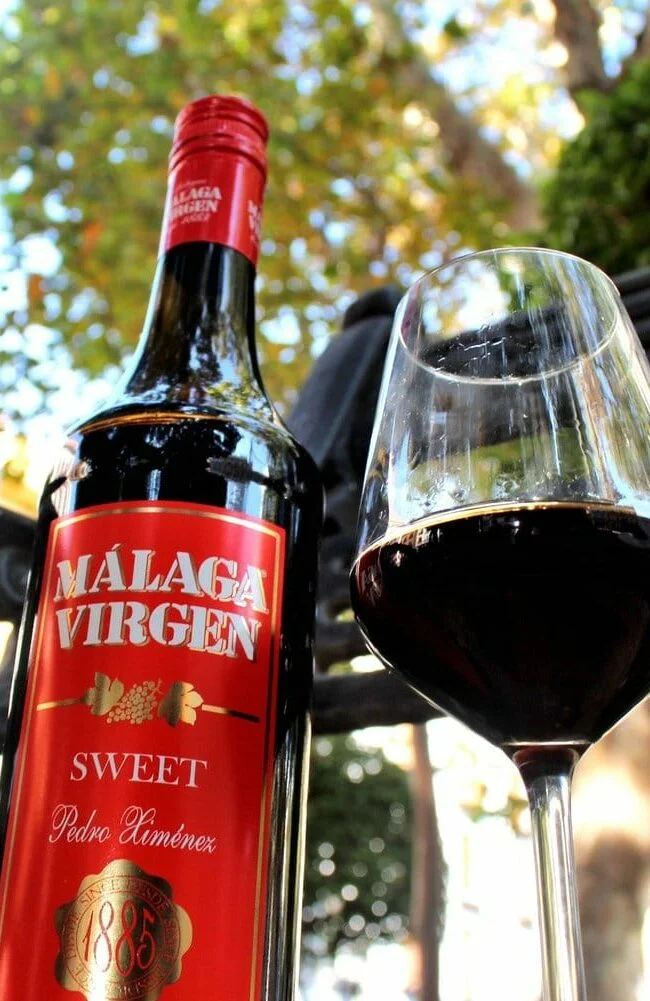

Montilla – Moriles
Montilla – Moriles lies within the province of Cordoba.
The predominant grape is the Pedro Ximenez.
The sweet wines of this region have an alcohol content of 15 – 18%, and are hearty. It is a favourite with devotees of sweet wines.
Condado de Huelva
Condado (county) de Huelva is a sweet wine producing area in the province of Huelva.
It is small compared to those referred to above.
Grapes used are Zalema, Moscatel, Palomino and Listan grapes.
I have not seen this wine in Antequera. You will likely find it available in Sevilla if visiting.

Wine Production near ANTEQUERA

Mollina is just north of Antequera. The bodegas are a 20 minutes drive away.
One of the wines from here, that you will find in Antequera restaurants (though, curiously not in the supermarkets) is Montespejo.
It is a joven dry white wine, and classically a blend of Lairen, Moscatel, and Doradilla grapes.
Montespejo should be sold at 12 euros or less.
It is a good value young wine.
It seems though, in Antequera at least, to be increasingly overtaken on wine lists by the better qualified (for the price) verdejo grape wines.
